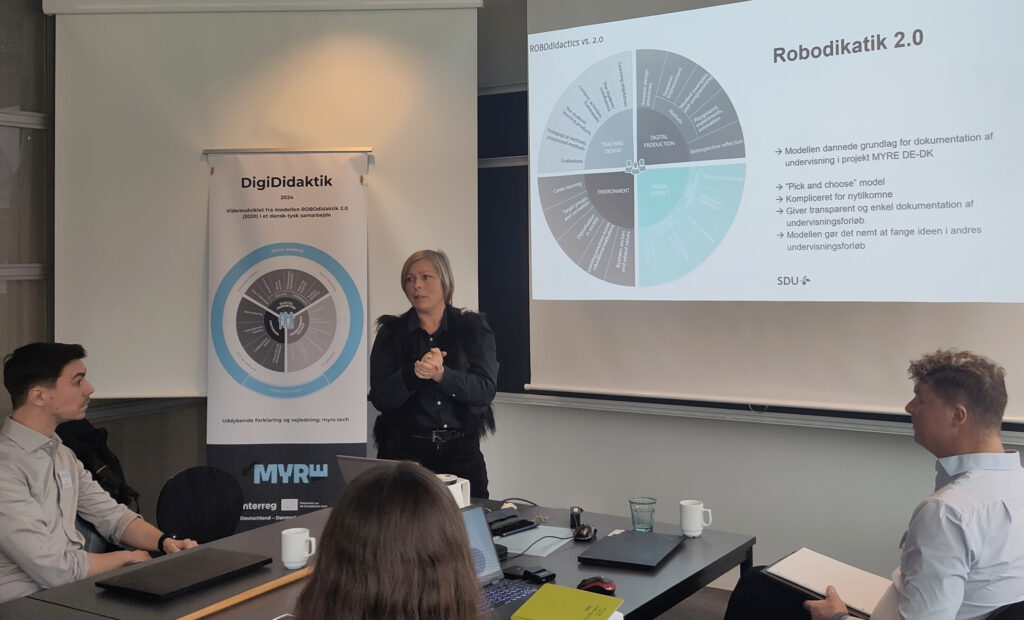The process behind Digidactics
The tech-didactic model DigiDidactics emerged from the previous version of the tech-didactic model ´ROBOdidactics´ (Majgaard et al., 2019).
The process behind included crucial and inescapable principles, which had also been fundamental to ROBOdidactics:
– The model should maintain its user-generated, user-directed, and non-normative approach, with a student-centered emphasis.
– The redesign should be data-driven and experience-based, as reflected in the teaching modules.
– The model should be meaningful for all target groups across the ´education chain´, and, as a new feature, across the Danish-German border.
A profound work proces for further developing ROBOdidactics included the following steps:
1) Identified needs for further development (January-August 2024):
The needs primarily encompassed simplifying the model, adopting a new title, and introducing a stronger focus on sustainability and international aspects. Furthermore, the elements of the model required a detailed review and refinement.
2) Preparation:
Data on the use of ROBOdidactics and its elements (2018–2024), collected through teachers’ work on a total of 105 teaching modules, as well as their exchange and discussions on these modules.
Principles of sustainability, based on the Brundtland Report and the UN Sustainable Development Goals.
3) Transnational didactic workshop, 19th September 2024, Kiel:
A dialogue-based work process in small cross-national groups to revise the topics and elements of ROBOdidactics.
Led by the University of Southern Denmark (SDU) and facilitated by the project management of MYRE DK-DE, involving 15 teachers, lecturers, and education managers from Denmark and Germany.
4) Workshop results and conclusions (September 2024):
Results collected via post-its and video-recordings of group presentations. Concluded on by researchers from SDU.
5) Feedback process in MYRE DK-DE (October 2024):
The draft of the new model was sent to project members for their comments and feedback.
6) Graphic redesign with visual transformation of ROBOdidactics into ´DigiDidactics´ (October-November 2024)
7) Publication (December 2024):
Presented at MYRE DK-DE´s final event DK, 13th Nov. and final event DE, 21st Nov. 2024.
Included in a research paper and a joint didactic framework in the follow-up project MYREcross.
Results
The results were related to the 4 dimensions of ROBOdidactics: Teaching Design, Digital Production, Digital Literacy, and Environment. Suggestions included the elimination, renaming, or addition of elements.
Furthermore, the model´s crucial student-centered principle shouæld be highlighted more.
Sustainability as a new focus was emphasized as relevant for all fields, covering environmental, social, and strategic aspects. There was not enough time to elaborate on specific content, but a few concrete cases emerged, such as making programming more reusable.
A more radical suggestion proposed virtualizing the model as a 3-dimensional version with a new shape. While digital literacy would form a surrounding ring, the other quadrants would be placed in the center. Additionally, a multi-color approach was requested.
14 title suggestions were collected in plenary through a joint brainstorming session, including “DigiDidactics,” abbreviations with meaningful letters, and “MYRE-Didactics.”
Finally, the addition of a taxonomy was proposed.
Critical voices were also raised. In particular, new teachers emphasized the need for lower complexity and easier onboarding to the model.
Others requested the possibility of subject-specific lesson planning supported by the model. However, it was clarified that ROBOdidactics (and now DigiDidactics) is a generic model intended for use at a meta-level.
It´s been a great day! We have learnt so much more about each other´s way of thinking and teaching. I love this new model!
Jan Nielsen, lecturer, Svendborg HHX



Conclusions and decisions
Researchers from SDU reviewed the recommendations developed by the participants during the didactic workshop. The process was fully documented and made accessible via the internal project site (Trello).
The data was clustered and incorporated into the foundational dataset (an Excel sheet), remaining faithful to the suggestions that had emerged.
Sustainability was introduced as a new overarching dimension, though without further specification. As a preliminary solution, one of the researchers supplemented the underlying guideline for ROBOdidactics with their own expertise in the field.
A new graphic design was drafted to emphasize a stronger focus on the student-centered principle, sustainability, and a structure that better accommodates Digital Literacy than before.
A 3-dimensional virtual model was omitted due to concerns about workload and unclear responsibilities for its construction and future maintenance.
The chosen title was “DigiDidactics.” This decision was made because the title is immediately understandable and was proposed both by some workshop participants and previously by educational practitioners outside MYRE DK-DE.
The feedback process among project members resulted in a few requests for adjustments, most of which could be accommodated.
Altogether, the user-involving and thus time-consuming process has paid off. However, it has also resulted in additional remaining tasks and visions. The next steps have been identified. As a framework for further development, the Danish-German follow-up project MYREcross was considered, and for some aspects, the Danish project MYREmidt (2024–2026).




The guideline for ROBOdidactics (2022) may be used as a prelimenary guideline:
Left overs and next steps
Some aspects of the model still require further refinement, particularly in integrating sustainability more concretely.
The most pressing task is to create a guideline for DigiDidactics. Many parts of the existing ROBOdidactics guideline may be reusable, but a thorough update and overhaul are necessary. This guideline could also include suggestions for a taxonomy to be considered.
Further development will focus on ensuring easier onboarding for new teachers while maintaining the model’s generic and meta-level applicability. Simpler versions of DigiDidactics, without outlining elements, have already been drafted and will be further explored.
Finally, preparations for publication and dissemination through new channels are in the planning stage.
MYRE DK-DE has received financial support from PKP | Interreg Deutschland – Danmark.
In addition to the 35% co-financing, the three project partners have contributed significant own resources and engaged a wide range of network partners.






